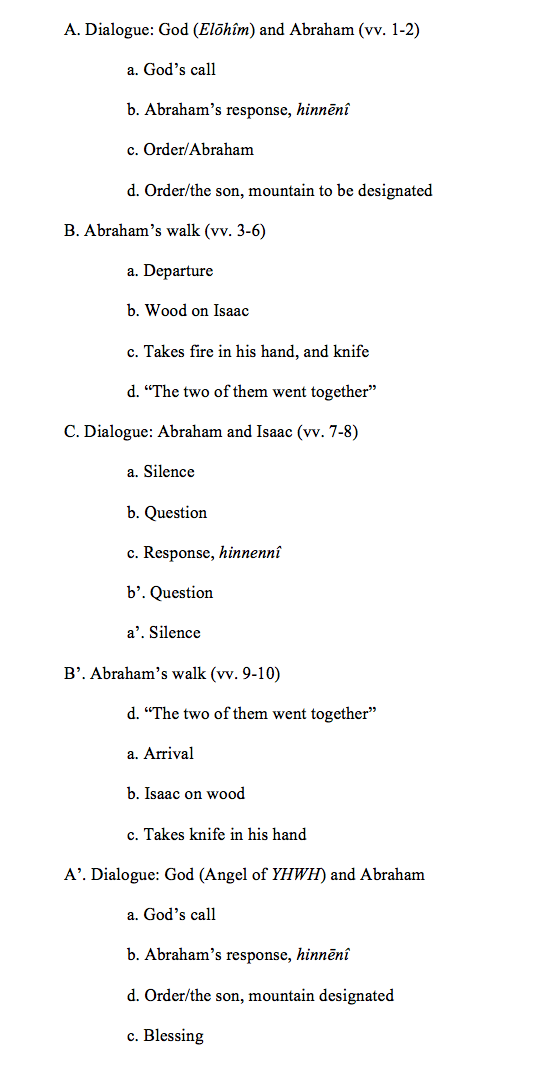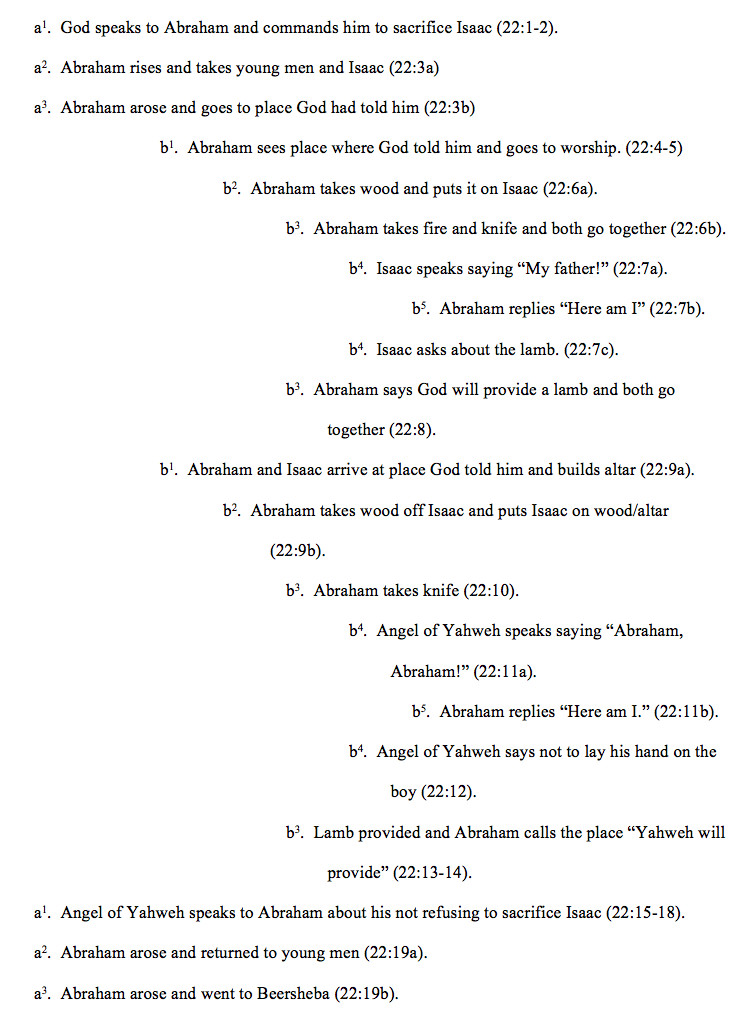Chiastic structures abound in the book of Genesis. For example, the Flood narrative is one long chiasm, as is the life of Abraham. It is the contention of this brief study that Gen. 22:1-19, also known as the Aqedah, is another such passage. And this structure reveals a talented author who gives us a foreshadowing of the Incarnation.
Discussing the Aqedah, Hamilton aptly states, “The test for Abraham is not primarily whether to sacrifice a beloved son, thought [sic] that is no doubt involved emotionally. The real test is whether Abraham will sacrifice the one person who can perpetuate the promises of God, and particularly those promises that his posterity should thrive.”[1]
This is a significant reason why the Aqedah points to the future binding of Jesus, who was led up the mountain by his Father many ages later on another lonely road. The structure and literary movement of this passage likewise points to this future sacrifice. In addition, the structure dispels any hint that it is composed of separate sources as source critical studies set forth,[2] since the structure reinforces the unity of the pericope itself. Lastly, the passage demonstrates a high degree of literary artistry and beauty that has been masterfully hidden within the warp and woof of the literary fabric.
Various organizing structures, chiastic and non-chiastic, have been proposed over the years for Gen. 22:1-19.[3] The most thorough and straightforward of these is the chiastic structure proposed by Jacques Doukhan:[4]

While this outline is indeed helpful, there are yet a number of deficiencies in Doukhan’s chiasm. The C section, the dialogue between Abraham and Isaac in verses 7-8, is still part of “Abraham’s walk,” since they have not achieved their destination; C should be subsumed under B. Within the C section itself, Doukhan mentions corresponding periods of silence, but this is an interpolation. Given the solemn nature of the journey, I’m sure there were periods of contemplative silence, but the text does not mention them. Doukhan’s analysis also misses points of correspondence that surely go together (as we will see anon). Abraham’s reply, hinnēnî, to both Isaac and the Angel of Yahweh in 22:7a and 22:11b must be taken as parallel. Also, Abraham’s words in 22:8, where he says that God will provide a lamb for the sacrifice, is parallel to 22:13-14 where the ram is provided for the offering. Doukhan’s analysis is a good first step for further investigation and improvement.
The overarching and organizing structure of Gen. 22:1-19 can be set forth out as follows:

In part 2 of this investigation, we’ll take a brief look at the various sections of this structure and draw some conclusions.
Kelly Kerr teaches at Franklin Classical School in Franklin, Tennessee.
[1] Victor P. Hamilton, The Book of Genesis Chapters 18-50 (NICOT; Grand Rapids, Michigan: Eerdmans, 1995), 103-4; see also Nahum Sarna (gen. ed.), Genesis, vol. 1 of The JPS Torah Commentary (Philadelphia, Pennsylvania: The Jewish Publication Society, 1989), 392-3.
[2] Verses 15-18 are considered by source critical analyses as secondary, for instance, L. R. Bailey, The Pentateuch (Nashville: Abingdon, 1981), 148; Claus Westermann, Genesis 12-36 (trans. John J. Scullion; CC; Minneapolis, Minnesota: Fortress Press, 1995), 355, 363; E. A. Speiser, Genesis, vol. 1 of The Anchor Bible (New York: Doubleday, 1964), 166; J. A. Emerson, “The origin of the promises to the Patriarchs in the older sources of the book of Genesis,” VT 32 (1982), 18.
[3] For example, Kenneth A. Matthews, Genesis 11:27-50:26 (NAC; Nashville, Tenessee: Broadman & Holman, 2005), 287-288, who proposes a threefold movement from Beersheba to Moriah, the climb up Mt. Moriah, and lastly at Moriah and the return to Beersheba; Gordon Wenham, Genesis 16-50 (WBC; Nashville, Tenessess; Thomas Nelson, 1994), who offers a chiastic outline based on narrative, monologue and dialogue sections:
N (v. 1a)
M (vv. 1b-2)
N (v. 3)
D (vv. 4-6b)
D (vv. 6c-8)
N (vv. 9-10)
M (vv. 11-18)
N (v. 19),
Though there is not much actual correspondence between sections outside of the narrative/monologue/dialogue classification; see also Yitzhak Avishur, Studies in Biblical Narrative: Style, Structure, and the Ancient Near Eastern Literary Background (Tel-Aviv, Israel: Graphit Press, 1999), 75-78.
[4] Jacques Doukhan, “The Center of the Aqedah: A Study of the Literary Structure of Genesis 22:1-19,” AUSS 31 (1993), 17-28.
